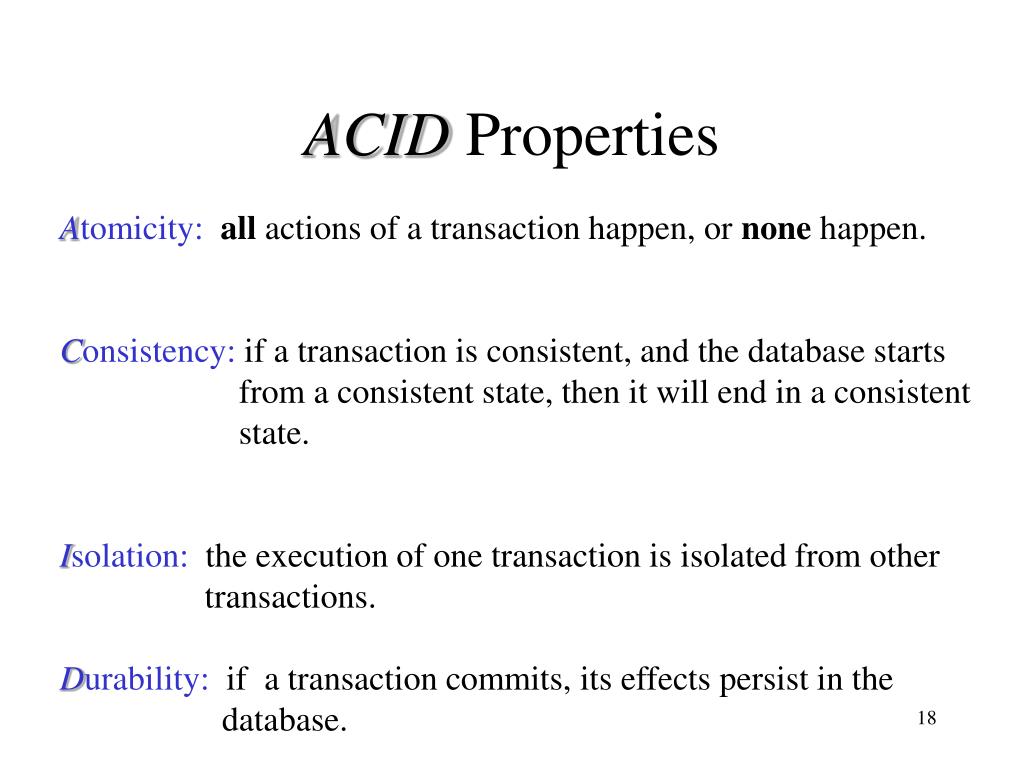

So either both of them should succeed or none of them, that’s what is the Atomicity of a transaction. So that the database is in a state that is similar to before we have begin the transaction. If one of them fails, the data that’s modified by the other states should be undone and rolled back. So the Atomicity of a transaction states that both of these statements should be treated as one unit. And these two statements are wrapped inside a transaction. The first statement updates TblProducts and the next statement inserts a row into the TblProductSale table. Where Id = 1 Insert into TblProductSale values( 3, 1, 10,GETDATE())
#Acid properties sql update#
Update TblProducts set Quantity = (Quantity - 10) So that’s what below transaction is doing here. Update TblProducts and insert a row into TblProductSale. And then we also have to make an entry into TblProductSale.īasically when we sell a product, two things happening. So we have to update quantity available to 100-10=90. The first thing that I have to do here is to check, what’s the quantity available for Books? And then from that quantity available, I will have to deduct the 10 Books that I am selling. Let’s say, for example, I’m selling 10 Books. So when we sell a product two think should happen first, we should check the quantity available. Now, whenever we sell a product an entry should also be made into the TblProductSale table.

TblProducts is like an inventory table that contains information about the products and the quantity available. Script Date: 9:52:33 PM ******/ SET ANSI_NULLS ON GO SET QUOTED_IDENTIFIER ON GO CREATE TABLE. Commit: This command is used to save the changes made by a transaction permanently, after all the operations within a transaction have been executed successfully.GO /****** Object: Table.All the operations that follow this command will be considered part of the transaction. Begin Transaction: This command is used to mark the start of a transaction.In order to apply SQL transaction properties effectively, it is essential to understand some key concepts that revolve around them. Key concepts of SQL transaction properties Understanding the different isolation levels and their impact is crucial to select the most suitable one according to the application requirements. ACID stands for Atomicity, Consistency, Isolation, and Durability.ĭepending on the isolation levels, we can have different types of anomalies like dirty reads, non-repeatable reads, and phantom reads. SQL transaction properties, also known as the ACID properties, define the essential characteristics of a transaction. They help in maintaining data consistency and integrity, especially in cases of concurrent access and system failures. Transactions are a sequence of one or more SQL operations that are executed as a single unit of work. Understanding SQL Transaction Properties Explained Let's dive deep into SQL transaction properties and explore their key concepts. Having a solid understanding of these properties can help you build robust and reliable data management applications. SQL transaction properties play a vital role in achieving this goal. When working with databases, it is crucial to ensure data consistency and integrity. Introduction to SQL Transaction Properties Begin your journey into the world of SQL transactions by delving into this informative and engaging resource. Finally, the comprehensive list of SQL transaction properties will be provided, along with a discussion on their importance for successful database management. Furthermore, you'll be exposed to the significance of transaction ACID properties in SQL Server and how these critical components ensure reliable and consistent transactions in your database system. This article introduces the key concepts of SQL transaction properties, guiding you through their types, examples, and applications. In the realm of computer science, understanding SQL transaction properties is an essential skill for effectively managing databases. Data Representation in Computer Science.Process Management in Operating Systems.
#Acid properties sql how to#
How to return multiple values from a function in C.C Program to Find Roots of Quadratic Equation.Automatically Creating Arrays in Python.


 0 kommentar(er)
0 kommentar(er)
